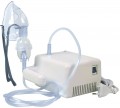Medicine container
The nebuliser's built-in medicine reservoir volume is a crucial consideration. It's important to align this parameter with medical guidelines for the prescribed treatment. A too-small capacity may require frequent refilling, disrupting the treatment process.
Also, knowing the volume of the reservoir and the nebulization rate (see below), it is possible to estimate the operating time of the nebuliser on a single refill.
Compressor power
The power consumed by the compressor of the nebuliser during operation; in this case, it means not only the corresponding element of compressor models (see "Type"), but also the nebulizer in ultrasonic devices.
The performance and power consumption of the nebuliser depend on this parameter. The more powerful the compressor, the higher the possible air flow rate and, accordingly, nebulization. At the same time, powerful devices consume more power (which is especially important when powered offline, see below) and can generate quite a lot of noise.
Max air flow
The maximum air output of a compressor nebuliser during operation is a key factor to consider. It's important to note that actual performance during normal operation is often lower. Different applications have recommended air flow intensities, and knowing this parameter helps assess how well the inhaler aligns with specific recommendations.
Nebulization rate
The nebuliser's nebulization capacity per minute.
The ideal nebulization rate can differ based on factors such as the patient's health condition, the type of disease, and the composition of the inhaled medication, as outlined in medical guidelines. This rate is crucial in assessing the inhaler's effectiveness for specific situations and also influences how long the device operates on a single medication refill.
Some models have a nebulization speed control — in such cases, the maximum value is usually indicated in the characteristics.
Particle size
The aerosol generated by a nebuliser contains droplets of varying sizes. Smaller droplets have an easier time reaching the narrow passages of the bronchi, delivering the medicinal substance deeper into the respiratory system. For optimal therapeutic effects, it is recommended that droplet sizes do not surpass 5 microns. It's worth noting that during the atomization process, particles may vary in size, and their values are often expressed as a range.
Medium particle size (MMAD)
Since not all particles have the same size, this paragraph indicates exactly the average, most common particle size when splitting in this inhaler. Accordingly, lower values allow easier and deeper penetration into the bronchi.

